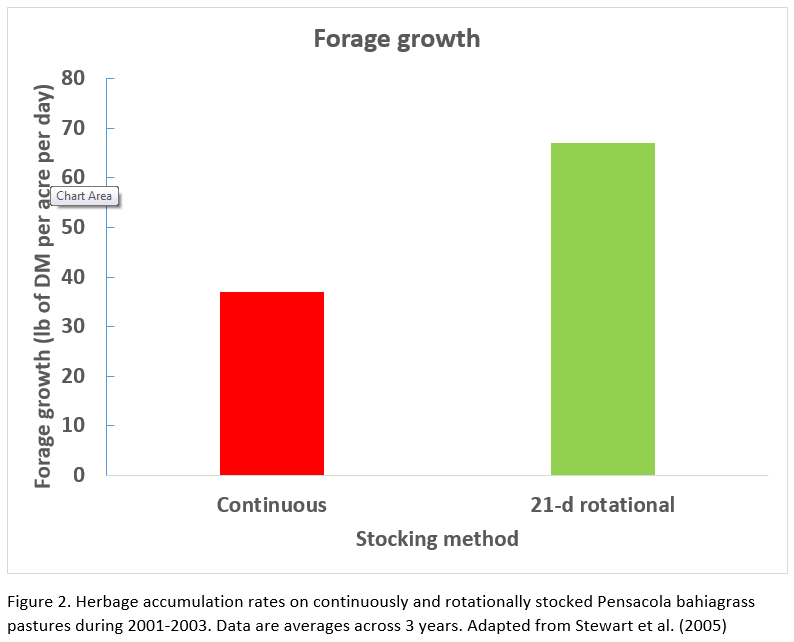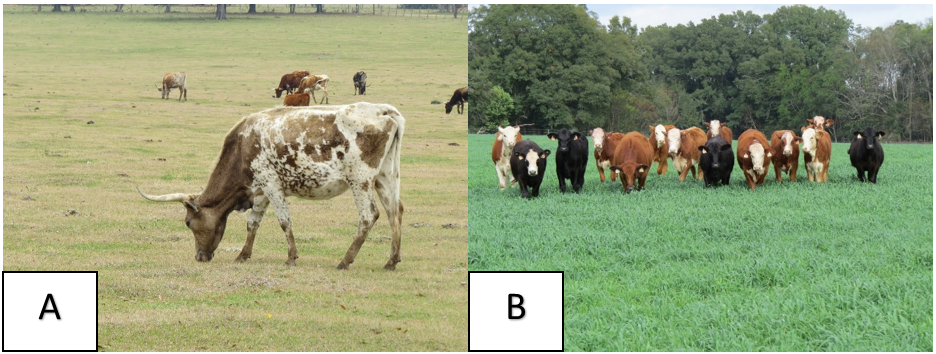Jose Dubeux, , University of Florida/IFAS – North Florida Research and Education Center (NFREC)
Pastures are different than hay fields or row crops. The final product is not the crop per se, but the animal gain obtained from grazing it. As a result, livestock need to be managed to graze (harvest) the forage efficiently and transform it into weight gain. If a producer excels at forage production, but doesn’t manage livestock grazing well, potential profits will be reduced. Grazing management is the single most powerful management tool to maximize gain with the available resources. Optimal weight gain can be achieved when maximum forage production is obtained, the forage utilization is adequate, and livestock are efficient in the transformation of forage into gain.
Adjusting the stocking rate to the forage production of the pasture is the most important grazing management tool to improve forage utilization. Overgrazing will not only reduce animal performance, but will also cause pasture decline, with stand loss and reduction in pasture productivity (Figure 1, A). Undergrazing, on the other hand, will also reduce animal gain per acre, by minimizing the animal’s potential weight gain. Producers should target the equilibrium between available forage and cattle weight. This “moving-target” is dynamic and depends on environmental factors, and the management applied. Newly formed leaves on growing plants are the most efficient in photosynthesis, but they are also preferred by livestock. Managing these contrasting interests of plants and animals requires both science and art. The art of observation and experience of the producer are key, but science is also an essential component of the equation to obtain desired outcomes. Ultimately, the goal is to leave enough forage behind to enable sustainable regrowth after grazing and maximize animal performance, without compromising pasture sustainability.
As a rule of thumb, only 50% of the forage produced should be grazed in perennial pastures to both maintain the pasture and optimize forage use. In annual cool-season forages, better utilization (60-65%) is expected considering that pasture persistence is not as important as in perennial systems. At a given level of annual forage productivity, increasing the forage utilization rate from 20 to 60% will increase by three fold the stocking rate (Table 1). This adjustment can only be made with frequent observations of the pastures, and continuous adjustment of the stocking rate. In intensive and more productive systems, this difference is significant and might lead to the profit (or losses) in a livestock operation. Remember, after all the investment on seed, fertilizer, equipment, and field operation, it is important to harvest (graze) forage efficiently to transform it into marketable products such as beef or milk. The stocking method is another important grazing management tool to improve grazing efficiency. Grazing methods include continuous and rotational grazing. In the continuous method, grazing livestock have uninterrupted access to forage during the entire grazing season. For rotational grazing, the pasture is divided into smaller subunits (at least two) and grazing is deferred for a period of time. In continuous stocking, grazing pressure will dictate the frequency, or how often grazing animals will return to the same patch. Frequent and intense defoliation will occur when pastures are overstocked. Rotational grazing has shown greater (67 lbs DM per acre per day) forage growth in Florida compared to continuous stocking (37 lbs DM per acre per day) on Pensacola bahiagrass (Stewart et al., 2005; Figure 2). In this case, the rotational schedule was 21 days of grazing and 21 days of rest, and only two paddocks were necessary. This reduces the need for a large investment in fencing and water troughs. Because forages usually grow slower right after defoliation, but begin to grow much faster after leaf area recovery, continuously grazed pastures may not allow enough recovery time for the faster growth to occur. Decisions regarding stocking method, however, depend upon the intensification of the system, the forage being grazed, and economic factors. Rotational grazing is more efficient in productive systems with high stocking rates, or when less grazing tolerant grasses are used (Bermudagrass), in order to improve their persistence.
The stocking method is another important grazing management tool to improve grazing efficiency. Grazing methods include continuous and rotational grazing. In the continuous method, grazing livestock have uninterrupted access to forage during the entire grazing season. For rotational grazing, the pasture is divided into smaller subunits (at least two) and grazing is deferred for a period of time. In continuous stocking, grazing pressure will dictate the frequency, or how often grazing animals will return to the same patch. Frequent and intense defoliation will occur when pastures are overstocked. Rotational grazing has shown greater (67 lbs DM per acre per day) forage growth in Florida compared to continuous stocking (37 lbs DM per acre per day) on Pensacola bahiagrass (Stewart et al., 2005; Figure 2). In this case, the rotational schedule was 21 days of grazing and 21 days of rest, and only two paddocks were necessary. This reduces the need for a large investment in fencing and water troughs. Because forages usually grow slower right after defoliation, but begin to grow much faster after leaf area recovery, continuously grazed pastures may not allow enough recovery time for the faster growth to occur. Decisions regarding stocking method, however, depend upon the intensification of the system, the forage being grazed, and economic factors. Rotational grazing is more efficient in productive systems with high stocking rates, or when less grazing tolerant grasses are used (Bermudagrass), in order to improve their persistence.
 Grazing management is a powerful tool to improve the profitability of a livestock enterprise. Proper adjustment of the stocking rate and the choice of grazing method may decide the difference between profit or loss for a farm.
Grazing management is a powerful tool to improve the profitability of a livestock enterprise. Proper adjustment of the stocking rate and the choice of grazing method may decide the difference between profit or loss for a farm.
Reference:
- 2025 UF/IFAS Forage Legume Conference – May 1 - March 28, 2025
- How are My Cool-season Forages Recovering from the Snowfall and Low Temperatures? - January 31, 2025
- Integrated Crop-Livestock Systems Improve Soil Health - July 26, 2024

